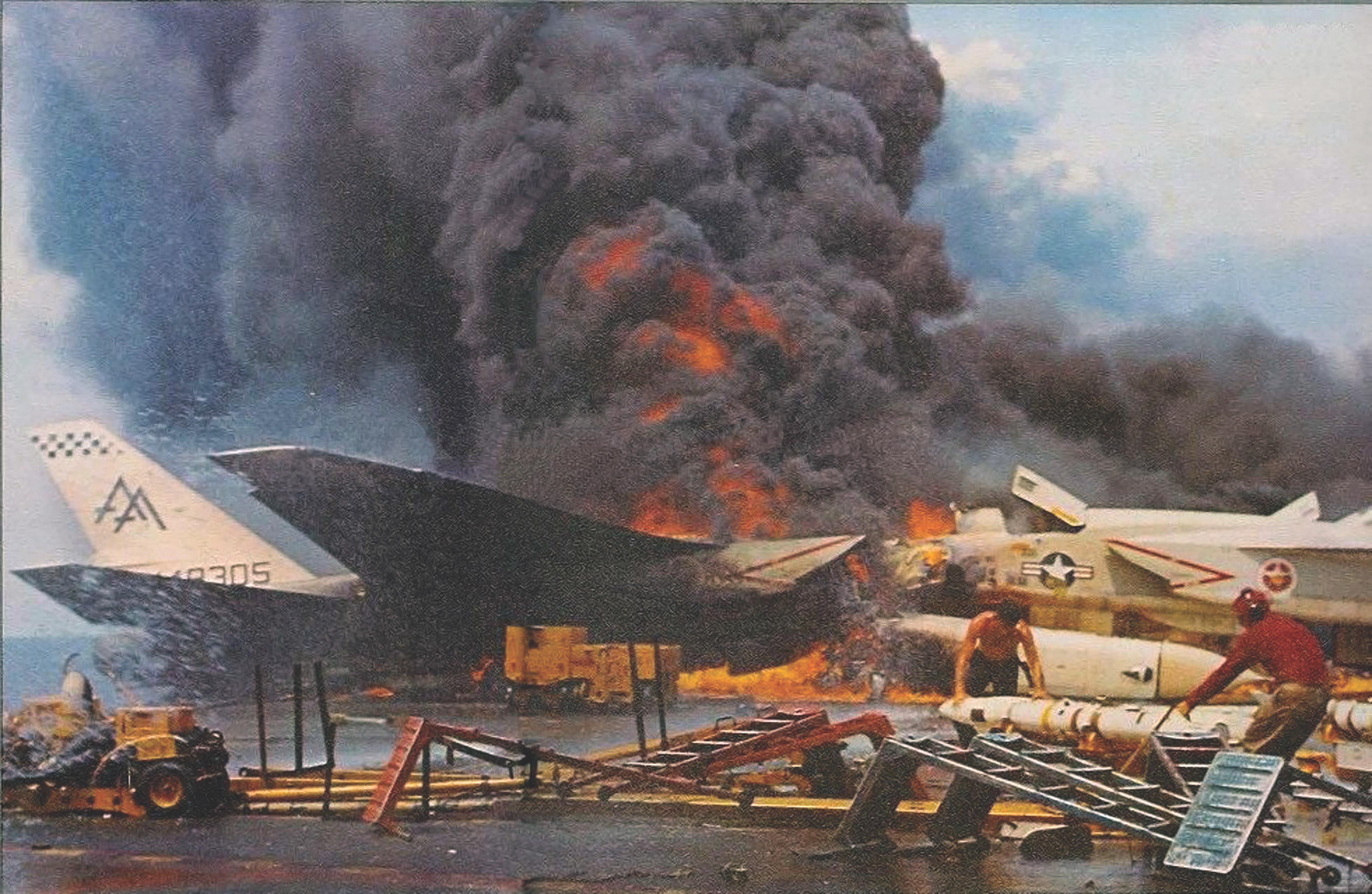To ignore Murphy’s Law—“anything that can go wrong will go wrong”—while conducting flight operations on an aircraft carrier is a capital offense. As 30-ton jets hurtle off the bow, controlled-crash landings are made on the stern and exhausts blaze, the slightest misstep or malfunction can be fatal.
In October 1966, the USS Oriskany in the Gulf of Tonkin off the North Vietnamese coast met disaster when a burning magnesium flare was tossed into a locker filled with flares and rocket warheads. Misfortune befell the USS Forrestal, also in the Gulf, in July 1967, when a rocket under the wing of a parked fighter burst on a crowded flight deck. In January 1969, a rocket aboard the nuclear-powered USS Enterprise off the coast of Pearl Harbor, Hawaii, was subjected to the heat of a jet engine starter, cooked off and sparked a chain reaction of explosions. In those three incidents, 206 American sailors died and 631 others were injured.
Government safety engineers had believed that strict safety and storage procedures on U.S. carriers would make explosive accidents merely a remote possibility. However, carelessness combined with unforeseen series of events meant that the possibility still remained. “There are 14 carriers in the fleet and I bet they have several fires a day when at sea,” estimated Lt. Cmdr. John Donnelly, executive officer of the U.S. Navy Damage Control Training Center, in a 1974 Popular Mechanics article. The Philadelphia facility was responsible for training sailors in damage control, including firefighting. “Fires have to be expected on a carrier,” Donnelly continued. “You can’t escape that fact—not with the overwhelming amount of fuel and explosives involved, mixing with carelessness and chance [with] 5,000 people living together in a relatively confined area.”
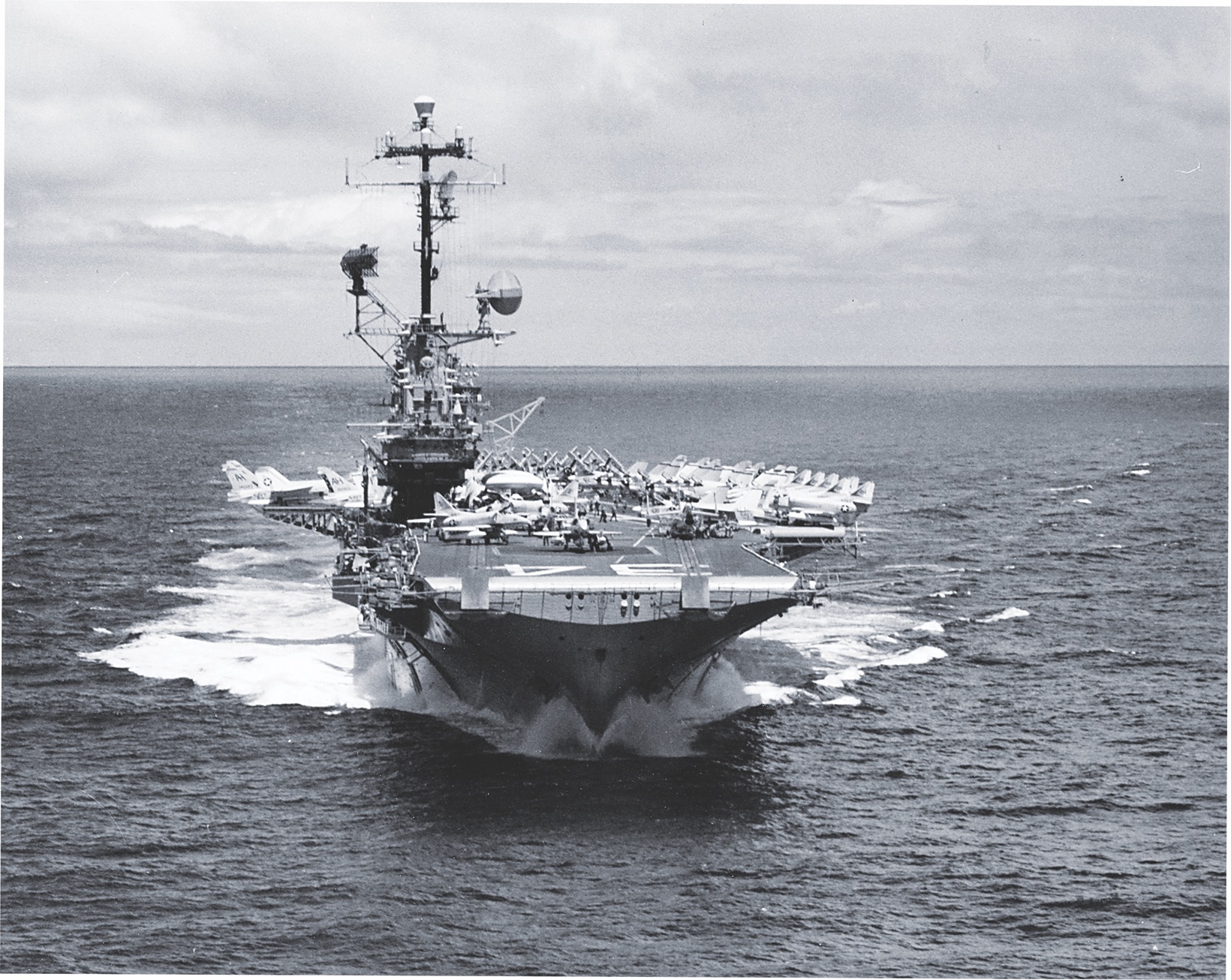
The Oriskany, dubbed “Mighty O,” was no stranger to accidents at sea. Off the coast of Korea in March 1953, an F4U-4 Corsair fighter landed with a bomb that fell off and exploded on touchdown. Pieces of shrapnel pierced several parked F9F-5 Panther jet fighters, whose punctured wingtip tanks poured burning fuel onto the hangar deck. Two sailors were killed and 15 wounded. However, firefighting crews prevented the flames from reaching any stored ordnance.
During the Oriskany’s second cruise off the coast of Vietnam, which began in July 1966, the carrier launched its five combat squadrons on nearly 8,000 sorties over four months. When Defense Secretary Robert McNamara noted after an Oct. 1 visit that crew members were exceeding Pentagon guidelines designed to prevent fatigue, Capt. John Iarrobino replied that mission demands forced him to disregard the guidelines. Just a few weeks later, the ship was about to sail for Hong Kong to give its crew a rest when the effects of overwork caught up with the Oriskany.
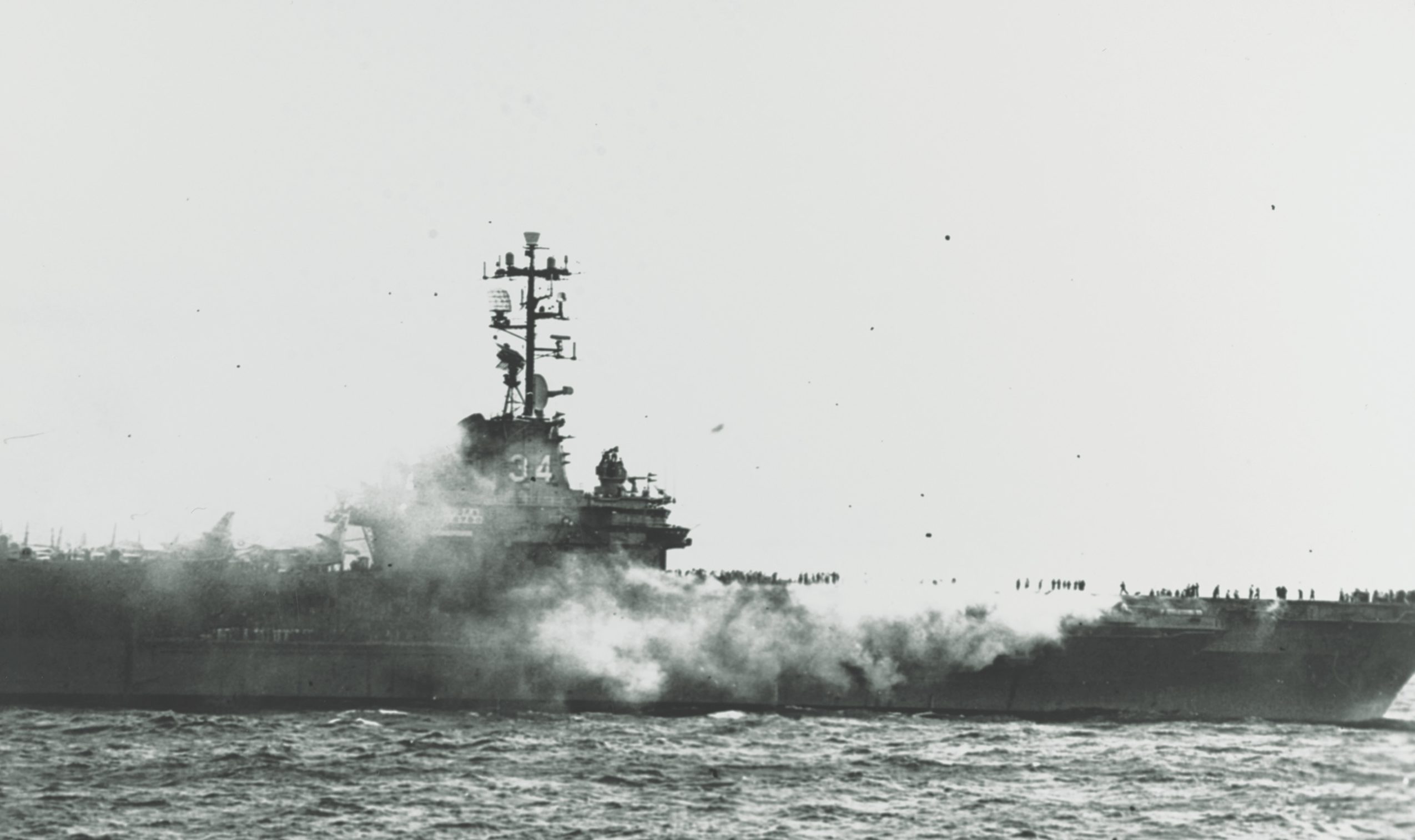
On the morning of Oct. 26, two apprentice airmen—George James, 18, and James Sider, 17—stowed 117 3-foot-long, 25-pound, cylindrical Mark 24 Mod 3 parachute flares. Neither man had been trained in the procedure nor supervised. Suddenly a flare’s safety lanyard snagged and detached, igniting the bright flare. Panicking and blinded by the in-tense, dazzling light of the burning Mark 24, Sider flung the flare into its storage locker, possibly hoping the lack of air in the case would smother the fire.
Unfortunately, the locker contained about 650 flares and 2¾-inch air-launched rockets, each containing a warhead of about 6 pounds. Within minutes the locker’s interior blazed at 4,500 degrees Fahrenheit. Explosions inside caused the steel bulkheads to sag and buckle. The hatch blew off.
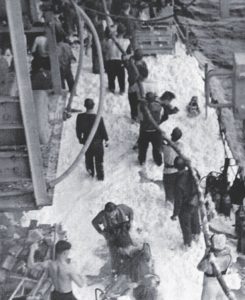
Successive explosions scattered burning magnesium everywhere, filling the hangar bay with toxic smoke. Two parked helicopters caught fire as the 20 mm cannon ammunition in a nearby A-4 Skyhawk fighter started to burn. A looming threat was the multitude of bombs staged for loading around the hangar. As the fire intensified, the paint on the bombs blistered and peeled, and their fuze inlets started smoking. Firemen poured water over the bombs until they could be rolled overboard. “If the bombs had gone off,” an officer later told Life magazine, “we would have lost the ship.”
Water proved useless against the fire itself. Water breaks down into oxygen and flammable hydrogen in a heat of over 3,000 degrees. Magnesium burns at up to 5,600 degrees. Due to hydrogen in the air, the hoses of firefighters and automatic sprinklers literally fed the flames. Iarrobino headed Oriskany into the wind to blow the smoke clear, while trying not to feed the fire. He flooded the carrier’s magazines to prevent ordnance from exploding.
Down in the carrier’s bowels, men fought for their lives against insufferable heat and smoke. Exhausted pilots were asleep in their quarters when the air system pumped toxic fumes inside and asphyxiated them. Others failed in attempts to escape through smoky, flaming passageways.
Trapped in his quarters, Lt. Cmdr. Marvin Reynolds wrapped a wet blanket around himself and fumbled in the noxious dark for a wrench to open his porthole. “Now just take it easy,” he said to himself. “If you let this wrench slip and lose it in the smoke, you’ve bought the farm.” He put his head through the porthole for air until a sailor above passed a breathing mask and fire hose to him.
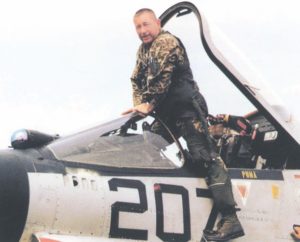
Cmdr. Richard Bellinger, leader of fighter squadron VF-162 and survivor of two dogfights with MiG fighters, ripped out his stateroom’s air conditioning unit mounted on the skin of the ship to get outside and escape the inferno, but then discovered that he had to strip naked before he could squeeze through the 18-inch opening onto the catwalk. According to some reports, he borrowed a flight suit or uniform and helped put out the fire.
Firemen poured water over the edges of the flames in the flare locker to keep them from spreading until the fire burned out, around mid-morning. Two flares in the locker never lit. Two others, and their wood packing crates, survived intact. So much water had been pumped aboard that scuba teams were required to rescue men trapped in the bottom of the ship.
Eight months later in the Gulf of Tonkin, the Forrestal, the first supercarrier designed specifically for jet aircraft, met a similar fate. Its flight crews flew 700 sorties in four days—so many that they ran low on streamlined modern low-drag bombs that packed huge explosive power. Capt. John Beling reluctantly accepted a load of decade-old AN-M65 “fat boy” thousand-pounders, blunt old bombs thin-skinned and rusty with age. They leaked Composition B, an explosive that becomes up to 50 percent more potent with age and is highly sensitive to shock and heat.
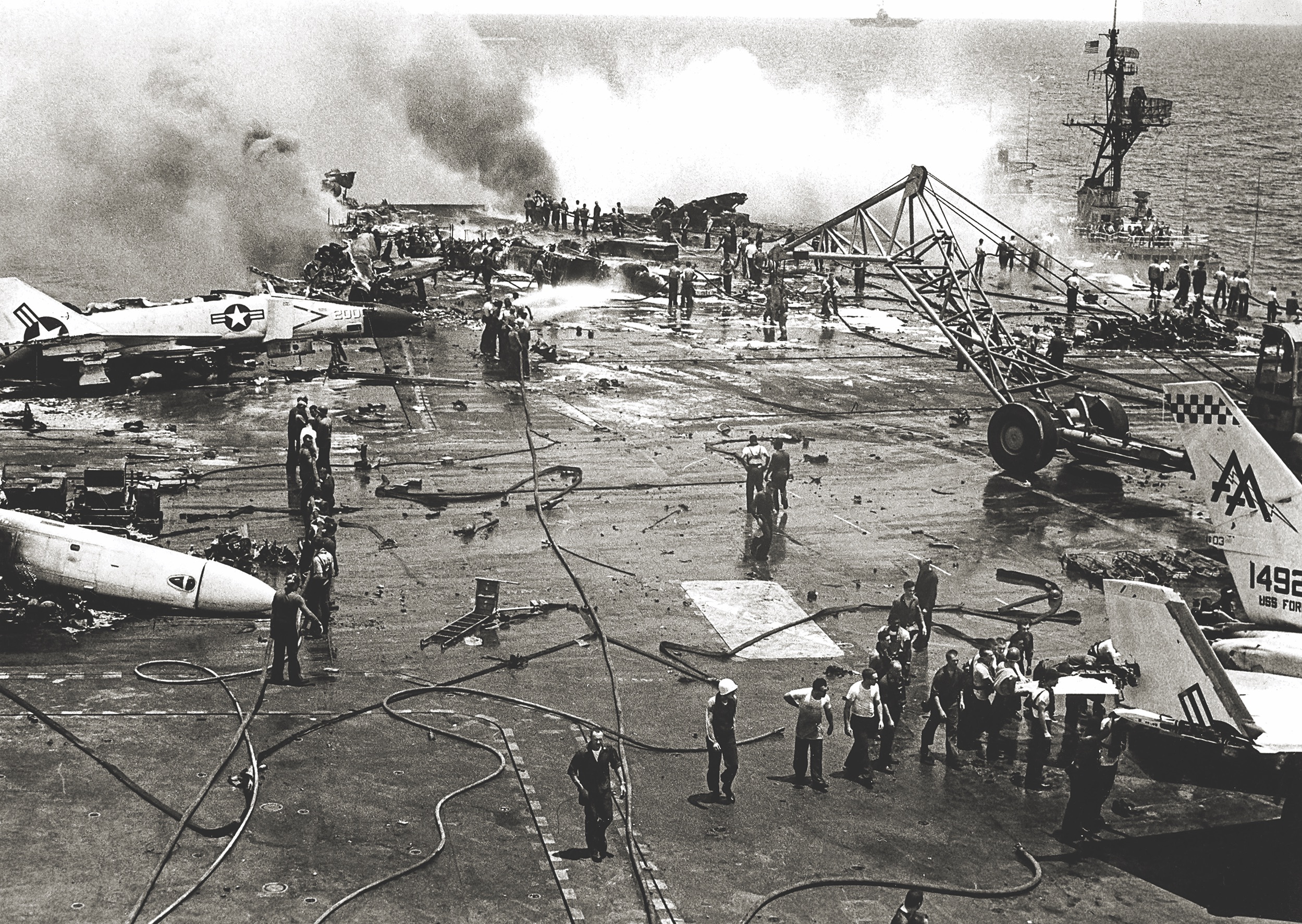
The bombs were on the deck July 29, 1967, shortly before 11 a.m., when a faulty launch circuit—which according to the Navy should not have been connected—released a 5-inch Mk-32 Zuni rocket from a F-4B Phantom II fighter parked starboard on the ship’s rear corner. The rocket flew straight through an A-4E Skyhawk without exploding before landing in the ocean, but on its way out the rocket punched open the jet’s fuel tank.
In normal circumstances, a lit match will not ignite the Navy’s primary jet fuel, JP-5, basically kerosene with a higher flashpoint than the JP-4 fuel used by the Air Force. Rocket and jet exhaust, however, are hot enough to set off JP-5, and once ignited the fuel can burn at up to 1,800 degrees Fahrenheit. With the carrier headed straight into the wind—standard launch procedure—the flames quickly spread to 10 nearby Skyhawks.
Damage-control teams went into action believing they had 10 minutes before the bombs on deck reached detonation temperature. However, the degraded Composition B explosive in the old bombs had become unstable. Only 96 seconds after the misfired rocket drilled the A-4 Skyhawk, one of the plane’s bombs cooked off.
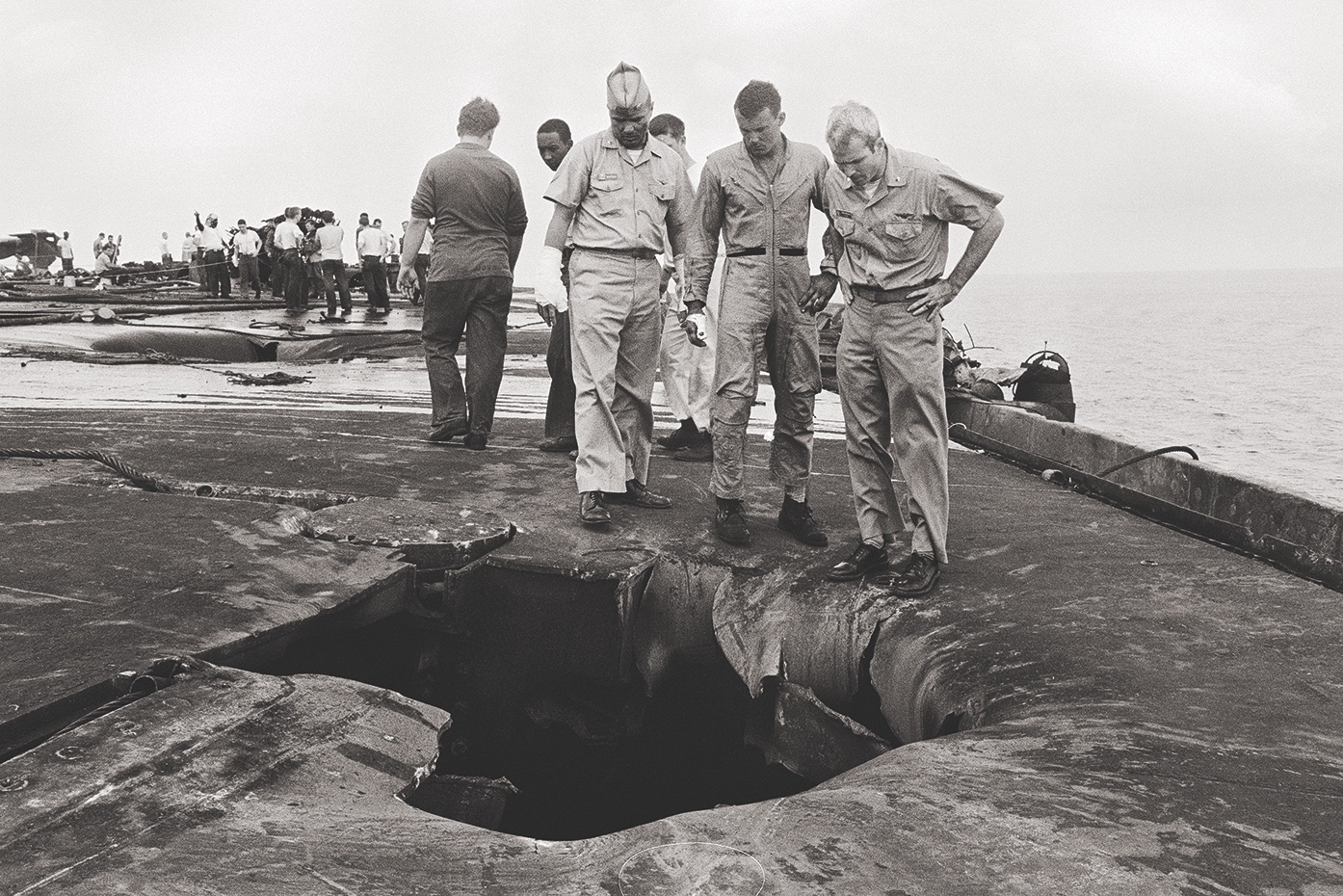
Future U.S. senator and presidential candidate John McCain was a lieutenant commander aboard the Forrestal in a Skyhawk parked next to the one that had been hit. “As I scrambled out of my aircraft and ran across the burning flight deck,” he recalled, “I watched as sailors carried hoses and extinguishers toward the flames. A moment later, the first bomb exploded, and those brave men were gone.”
The blast not only killed most of the lead firefighting crew and spattered blazing fuel across the deck but also blew a hole into the hangar bay. Within five minutes, nine major explosions shook the Forrestal, each spraying rescuers and aircraft with flames and fragments. Rockets and 20 mm cannon shells raked the deck. Ejection seats fired themselves. Skyhawk pilot Lt. Cmdr. Herb Hope escaped his plane and rolled off the flight deck into a safety net, then joined a damage control party below. “The port quarter of the flight deck, where I was,” he told them, “is no longer there.”
Some 40,000 gallons of leaked jet fuel poured through the Forrestal’s breached flight deck and filtered down three levels, deep into the ship. Everywhere the fuel went, fire followed. Most of the men in the damage-control parties were dead. Sailors with no firefighting training picked up the hoses because only half the ship’s crew, and none of the air wing, had been trained to fight fires.
“I watched them from the island [the structure housing the carrier’s towering command center],” one officer remembered. “They were having trouble. Fire had cut off plugs in the stern. Those amidships had developed pump problems. So the men had to haul hoses from the forward stations.”
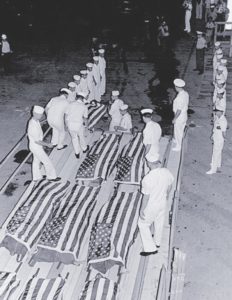
A team spraying a fire-extinguishing foam was followed by men who hauled water hoses and inadvertently washed the foam away. Overzealous use of hoses also destroyed delicate and costly computer gear untouched by fire. The fire suppressant crew laid down a buffer zone of foam to keep flames from spreading to the carrier’s island and rolled some surviving planes forward. Planes below decks were brought up and moved to the bow as well.
By noon the fire on the flight deck was under control. Helicopters from the Oriskany, back in service, picked up men who had jumped or fallen overboard. The destroyers USS George K. MacKenzie and Rupertus came alongside to pick up wounded and unleash fresh hoses at the blaze. Divider doors sealed off the lower hangar bays. Eventually, the fire was contained and largely extinguished, but alarms went off for two more days.
“I lost track of time,” reported Chief Petty Officer Gerard G. Johnson, “but I do know I was still putting out fires when the ship pulled into Subic Bay in the Philippines.” After the Forrestal disaster, Navy crews were given more thorough damage-control training.
When a similar accident struck the Enterprise, 96 percent of the crew and 86 percent of the air wing had attended fire-fighting school. The Navy’s first nuclear-powered aircraft carrier, the Enterprise was the world’s largest ship when it was launched in September 1960. The carrier was preparing for a fourth tour of Vietnam when an explosion occurred the morning of the Jan. 14, 1969.
The carrier, conducting flight exercises about 70 miles southwest of Pearl Harbor, had a crowded deck of F-4 Phantoms and A-7 Corsair II bombers, each loaded with Zuni rocket pods and 500-pound Mk-82 bombs. At 8:18 a.m. an MD-3A “Huffer” aircraft engine starter was parked with its exhaust outlet only 2 feet from a rocket pod under a Phantom’s wing. At this short distance, the Huffer’s exhaust heat—at least 326 degrees and possibly as high as 590 degrees—was a fire hazard. The 15 pounds of Composition B in a Mk-32 Zuni rocket warhead detonates at 358 degrees.

No less than four crewmen recognized the threat but did nothing during the one minute and 18 seconds they had before a Zuni rocket exploded.
“We started hearing explosions and we saw the fantail of the ship was black with smoke and orange flames shooting out,” recalled Seaman Apprentice Jim Girafalco, on deck as a lookout. “I thought I was in a vortex of hell.”
The exploding rocket ruptured the aluminum external fuel tanks on the Phantom carrying it, along with the tanks on several aircraft parked nearby. With the carrier moving at a speed of 10 knots (about 12 mph) into a 19-knot headwind (22 mph), the spilled JP-5 whisked into vapor and immediately burst into flame. The 15 nearest aircraft had a total fuel load of 15,000 gallons. They had a combined weapons load of 30 500-pound bombs and 40 Zuni rockets, which began heating up as burning fuel flooded the flight deck.
Only 20 seconds after the first explosion, three additional rockets in the Phantom’s rocket pod fired into the deck. After three minutes in an open flame, the first bomb exploded and blew an 8-foot hole in the 2½-inch-thick armored flight deck. Worse, the explosion knocked out two pumps supplying a foam extinguishant and cut the hoses.
Petty Officer 3rd Class Frank Neumayer of Fighter Squadron VF-96 was knocked unconscious to the deck by the initial blast. He awoke, beat out his blazing clothing, tore off his melted goggles and saw the burning fuel closing in around him. “The roar of the fire was just horrendous,” he said later. “It just blotted out any other sound. The stench… was horrible.”
Neumayer dragged himself off the edge of the deck onto the catwalk below just before two 500-pound bombs went off 10 yards away from his previous position. He lost his left leg and was given last rites twice, but survived.
The Enterprise was shaken by 18 successive explosions, raking crewmen with shrapnel, raining debris and fire, and ripping eight holes in the flight deck. “It’s hard to explain the power,” recalled fuel-gang leader Airman Mike Carlin. “The power…unbelievable violence just blew everybody like dust.”
A 500-pound bomb rolled through a hole in the flight deck, crashed through several decks below and passed out the carrier’s stern without exploding. But it left a hole just 3 feet above the waterline. Three bombs on a single rack went off at once, opening a 22-foot breach in the deck and spattering 6,000 gallons of JP-5 from a parked tanker jet. A pool of burning fuel poured across the aft flight deck and spilled six levels down into the ship.
The Enterprise’s crew created a firebreak, rolling undamaged aircraft forward where they were clear of the flames. “We were trying to protect the island,” recalled Warrant Officer Jim Helton, the carrier’s crash salvage officer. “If those [bombs on the planes] had gone, everybody in the island—the captain on the bridge, the air boss, all of those people—would have been trapped, and probably killed.”
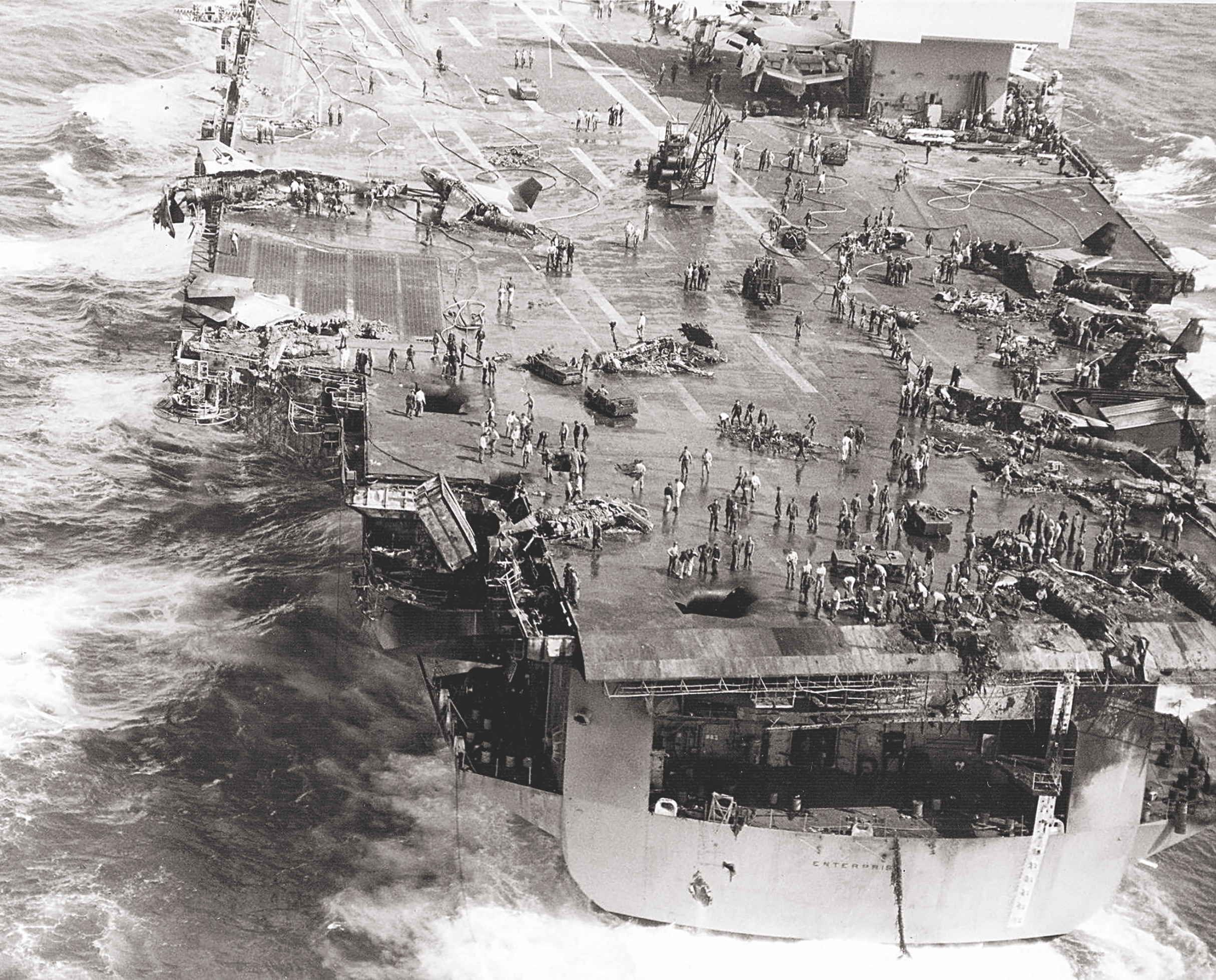
After the water mains were repaired and hose pressure restored, the Enterprise crew was able to fight the flames. The sailors poured foam through the holes in the deck to chase the burning fuel. The destroyer USS Rodgers and nuclear-powered guided missile destroyer USS Bainbridge came alongside to lend their hoses. By 10 a.m., helicopters from Pearl Harbor landed on deck to medevac wounded. By 11:30, just three hours after the fire started, the Enterprise was free of flames. “Big E” put back in to Pearl for 51 days of repairs before returning to duty.
The damage, in money and men, sustained by the three carriers was very costly. Repairs to the Oriskany took five months and tallied about $13 million ($103 million today). One crewman died of burns and 43, including 25 pilots, of smoke inhalation. An additional 156 were injured. Two helicopters and an A-4E Skyhawk were destroyed, and three more Skyhawks were badly damaged. The Navy charged five sailors, including James, Sider and their supervisor with manslaughter, but all were acquitted when investigators found that a Mark 24 flare could, if jarred, ignite itself.
The Oriskany made three more tours in Vietnam. In May 2006, the carrier was purposely sunk off Florida’s Gulf Coast, becoming the world’s largest artificial reef.
The Forrestal lost 21 aircraft destroyed, 134 men dead and 161 injured. Repairs over the winter of 1967-68 cost $72 million ($545 million today). An investigative board stated: “Poor and outdated doctrinal and technical documentation of ordnance and aircraft equipment and procedures, evident at all levels of command, was a contributing cause of the accidental rocket firing.”
Beling was absolved of personal responsibility. However, an expected appointment to command a carrier battle group was canceled by incoming Chief of Naval Operations Adm. Elmo Zuwalt. Beling was reassigned to the Iceland Defense Force and retired as a rear admiral.
When the Forrestal was decommissioned, there were plans to use it as a floating museum or artificial reef, but nothing came of them. The ship was sold for 1 cent in 2013 and cut for scrap in 2015.
The Enterprise fire resulted in 28 deaths and 314 injuries, 17 aircraft damaged and 15 destroyed, along with equipment and weapons. The cost of repairing the ship and replacing the lost equipment and aircraft totaled over $126 million ($912 mil-lion today). Disciplinary measures were moot. The crewmen believed to be responsible for the blaze were all killed in the initial blast. A Huffer redesign and revisions to safety and firefighting procedures were implemented.
The Enterprise made six combat deployments to Vietnam. After the war, off the coast of Virginia on Nov. 8, 1998, a Lockheed S-3 Vi-king aircraft, used in anti-submarine warfare, had just come aboard when a trailing Grumman EA-6B Prowler electronic-warfare jet waved off from landing, pulled out too late and clipped the S-3. The Prowler crashed into the sea, killing all four crewmen. The Viking exploded in a huge fireball. The ship’s crew got the fire under control in less than seven minutes.
In 2012, after sailing 51 years, the Enterprise was taken out of service and awaits its final fate at Virginia’s Newport News shipyard, where it is scheduled to stay until 2021.
Today a Nimitz-class supercarrier has 22 fire hose stations around the perimeter of its flight deck, a firefighting truck with a high-pressure hose turret and a 750-gallon onboard tank, and a wash-down system that can pump up to 27,000 gallons per minute.
In May 1981, during night operations off the Florida coast, a Prowler landed on the Nimitz off-center, clipped a parked helicopter and plowed into six other aircraft on the deck, creating a fire. The flames were contained and extinguished in 28 minutes. However, as deck crews moved in to clean up, four air-to-air missiles engulfed in the fire detonated in succession, killing 14 sailors. Total damage amounted over $58 million.
In November 1988, a 20 mm cannon in a jet parked on the Nimitz’s flight deck went off, killing one sailor and igniting six other aircraft, including a KA-6 air-to-air refueling tanker. A second sailor died of burns that covered more than 70 percent of his body. The crew extinguished the flames, and the Nimitz did not leave station.
There were two collisions involving U.S. destroyers running into civilian ships in June and August 2017, resulting in the deaths of 17 sailors. Those incidents, attributed to fatigue and crew errors, led the Navy to re-examine its safety procedures again. V
Don Hollway wrote about Air Force Col. Robin Olds and “Operation Bolo” in the February 2019 issue. For more information on the carrier fires, go to insensitivemunitions.org and the Navy documentary “Trial by Fire” at youtu.be/TGwoHyUvOqI.
This article was featured in the August 2020 issue of Vietnam magazine. For more stories from Vietnam magazine, subscribe here:

